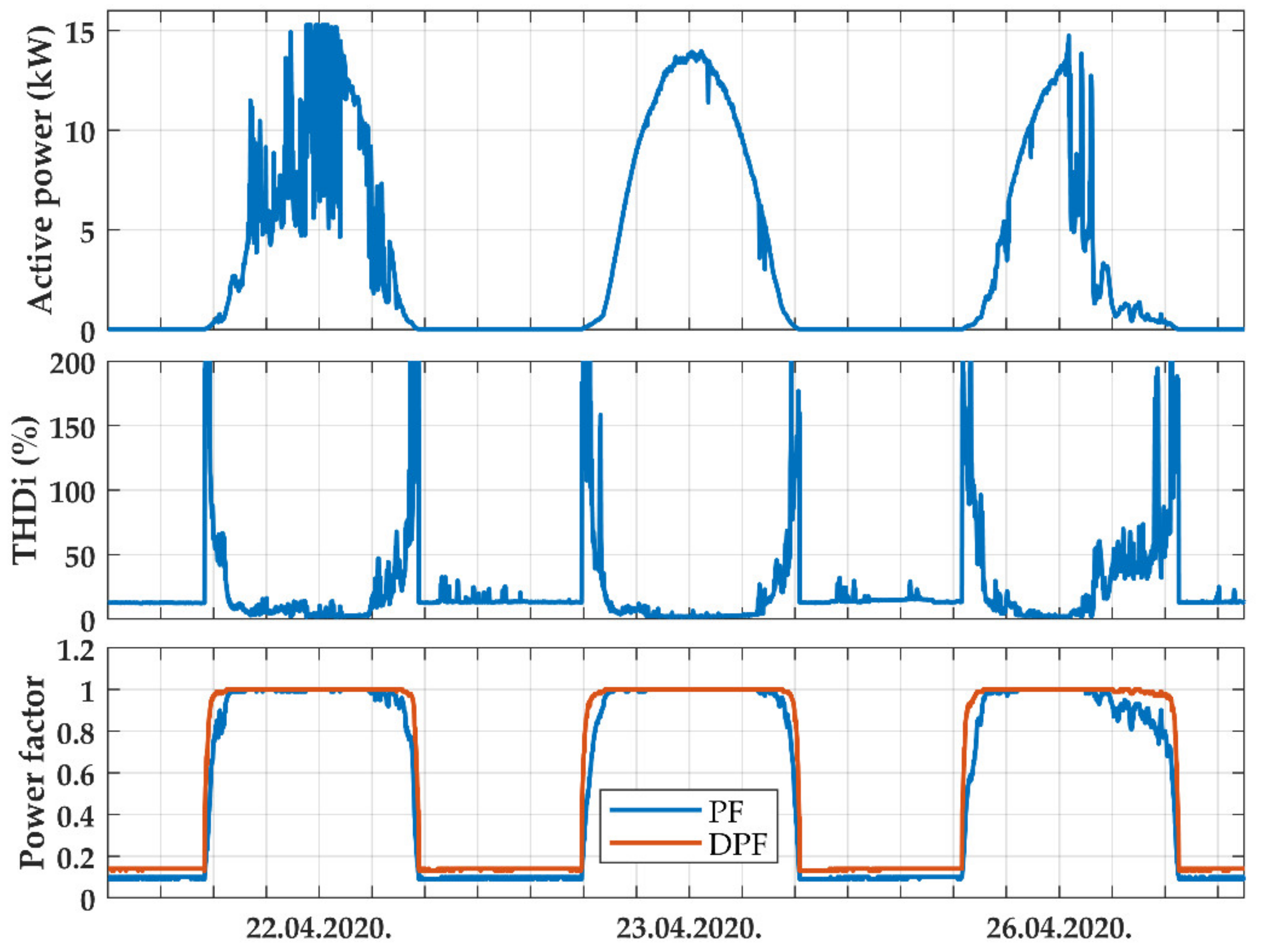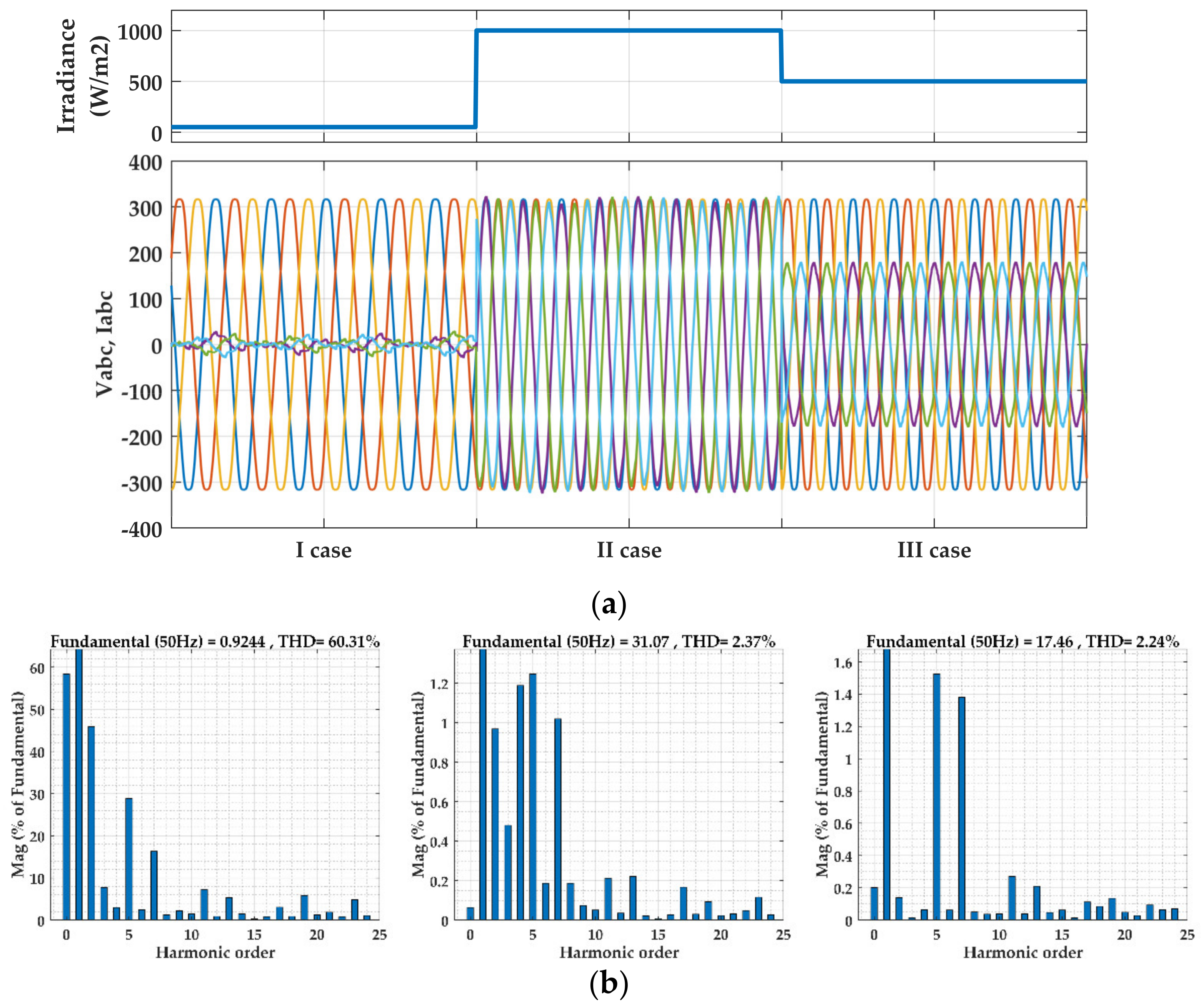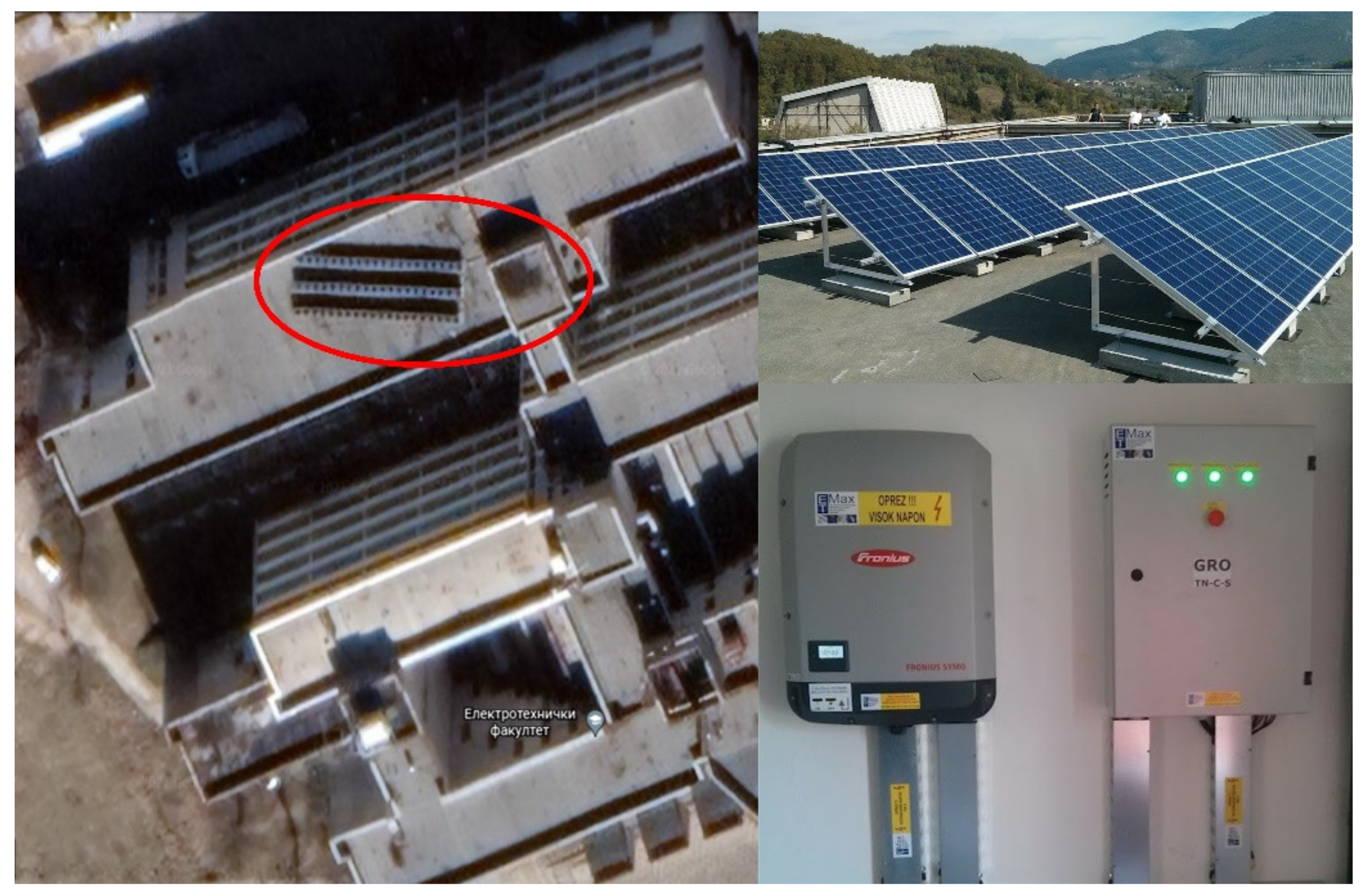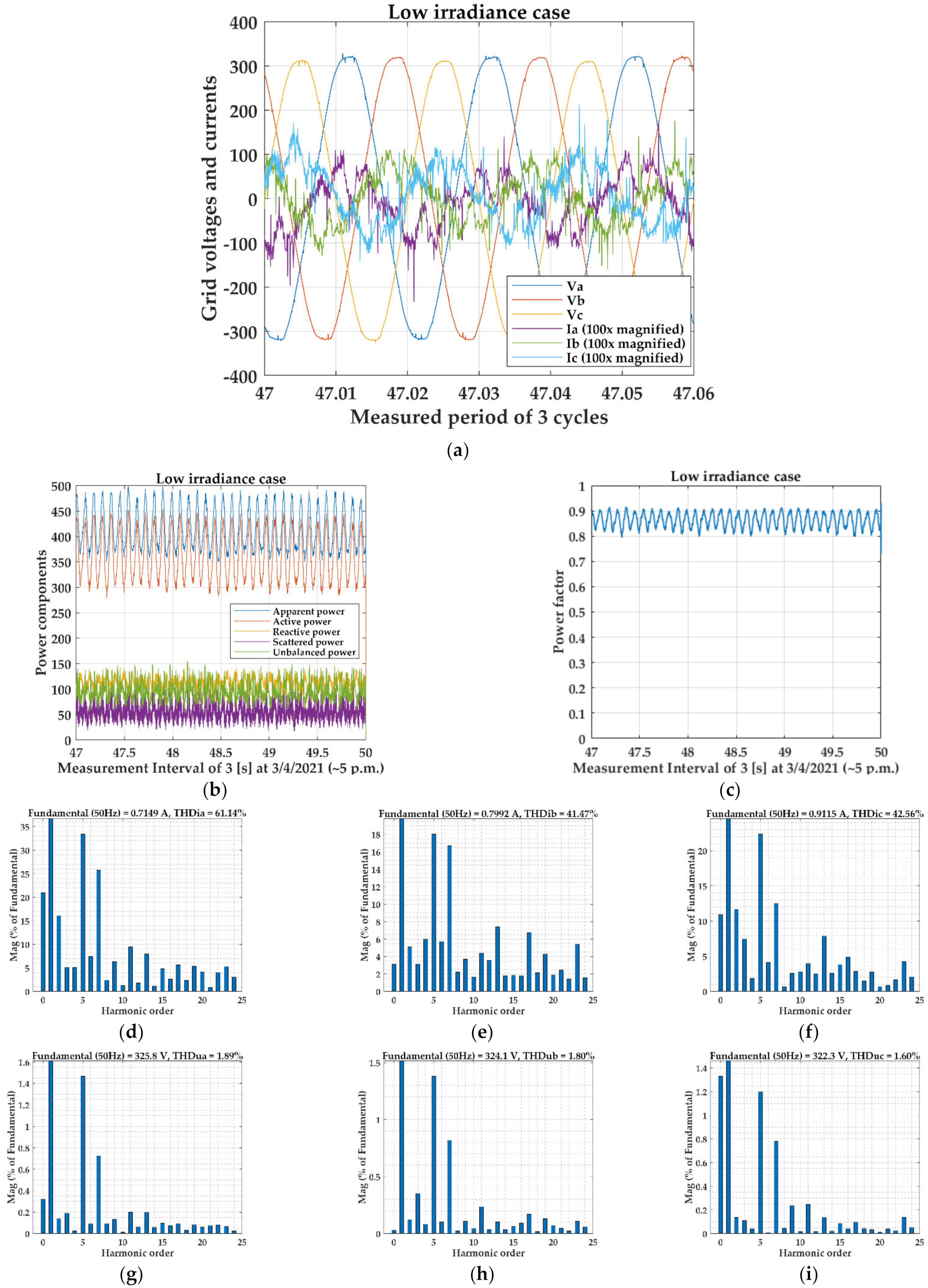Experimental Evaluation of Distortion Effect for Grid-Connected PV Systems with Reference to Different Types of Electric Power Quantities
Abstract
:1. Introduction
2. Theoretical Background and Used Methodology
2.1. Used Methodology
2.2. Simulation Model
2.3. Simulation Results
3. System Description and Experimental Setup
3.1. System Configuration
3.2. Measurement and Acquisition System
3.3. Experimental Results
4. Comparison of the Simulation and Experiment Results
5. Conclusions
Author Contributions
Funding
Acknowledgments
Conflicts of Interest
References
- Our World in Data. Available online: www.ourworldindata.org (accessed on 25 August 2021).
- Demirok, E.; González, P.C.; Frederiksen, K.H.B.; Sera, D.; Rodriguez, P.; Teodorescu, R. Local Reactive Power Control Methods for Overvoltage Prevention of Distributed Solar Inverters in Low-Voltage Grids. IEEE J. Photovolt. 2011, 1, 174–182. [Google Scholar] [CrossRef]
- Patsalides, M.; Evagorou, D.; Makrides, G.; Achilides, Z.; Georghiou, G.; Stavrou, A.; Efthimiou, V.; Zinsser, B.; Schmitt, W.; Werner, J. The Effect of Solar Irradiance on the Power Quality Behaviour of Grid Connected Photovoltaic Systems. Renew. Energy Power Qual. J. 2007, 1, 323–330. [Google Scholar] [CrossRef]
- Zainuddin, M.; Surusa, F.; Syafaruddin; Manjang, S. The Effect of Irradiance on Distribution Power System Stability in Large-Scale Grid-Connected Photovoltaic. In Proceedings of the 2019 International Conference on Information and Communications Technology (ICOIACT), Yogyakarta, Indonesia, 24–25 July 2019; pp. 805–810. [Google Scholar]
- De Silva, H.H.H.; Jayamaha, D.K.J.S.; Lidula, N.W.A. Power Quality Issues Due to High Penetration of Rooftop Solar PV in Low Voltage Distribution Networks: A Case Study. In Proceedings of the IEEE 14th International Conference on Industrial and Information Systems (ICIIS), Kandy, Sri Lanka, 18–20 December 2019; pp. 395–400. [Google Scholar]
- Elkholy, A. Harmonics assessment and mathematical modeling of power quality parameters for low voltage grid connected photovoltaic systems. Sol. Energy 2019, 183, 315–326. [Google Scholar] [CrossRef]
- Al-Shetwi, A.Q.; Hannan, M.A.; Jern, K.P.; Alkahatani, A.A.; PG Abas, A.E. Power Quality Assessment of Grid-Connected PV System in Compliance with the Recent Integration Requirements. Electronics 2020, 9, 366. [Google Scholar] [CrossRef] [Green Version]
- Smith, J.; Rönnberg, S.; Bollen, M.; Meyer, J.; Blanco, A.; Koo, K.L.; Mushamalirwa, D. Power Quality Aspects for Solar Power. CIGRE Working Group JWG C4/C6.29. CIRED-Open Access Proc. J. 2017, 2017, 809–813. [Google Scholar] [CrossRef] [Green Version]
- Ouai, A.; Mokrani, L.; Machmoum, M.; Houari, A. Control and energy management of a large scale grid-connected PV system for power quality improvement. Sol. Energy 2018, 171, 893–906. [Google Scholar] [CrossRef]
- Khomsi, C.; Bouzid, M.; Jelassi, K. Power Quality Improvement in a Three-Phase Grid Tied Photovoltaic System Supplying Unbalanced and Nonlinear Loads. Int. J. Renew. Energy Res. 2018, 8, 1165–1177. [Google Scholar]
- Reddy, C.; Goud, B.; Aymen, F.; Rao, G.S.; Bortoni, E. Power Quality Improvement in HRES Grid Connected System with FOPID Based Atom Search Optimization Technique. Energies 2021, 14, 5812. [Google Scholar] [CrossRef]
- IEEE Standard 1459; IEEE Standard Definitions for the Measurement of Electric Power Quantities under Sinusoidal, Non-Sinusoidal, Balanced or Unbalanced Conditions. IEEE Power & Energy Society: New York, NY, USA, 2010.
- Mikulović, J. Power Definitions for Electrical Circuits with Harmonic Distortions of Voltages and Currents. In Proceedings of the 18th International Symposium INFOTEH-JAHORINA, Jahorina, Bosnia and Herzegovina, 20–22 March 2019; pp. 34–42. [Google Scholar]
- Czarnecki, L.S. Currents’ Physical Components (CPC) Concept: A Fundamental of Power Theory. In Proceedings of the International School on Nonsinusoidal Currents and Compensation (ISNCC), Lagow, Poland, 10–13 June 2008. [Google Scholar]
- Czarnecki, L.S. Orthogonal decomposition of the currents in a 3-phase nonlinear asymmetrical circuit with a nonsinusoidal voltage source. IEEE Trans. Instrum. Meas. 1988, 37, 30–34. [Google Scholar] [CrossRef]
- Czarnecki, L.S. Physical Interpretation of the Reactive Power in Terms of CPC Power Theory. Electr. Power Qual. Util. 2007, 13, 89–95. [Google Scholar]
- Ahsan, S.M.; Khan, H.A.; Hussain, A.; Tariq, S.; Zaffar, N.A. Harmonic Analysis of Grid-Connected Solar PV Systems with Nonlinear Household Loads in Low-Voltage Distribution Networks. Sustainability 2021, 13, 3709. [Google Scholar] [CrossRef]
- Liang, X.; Andalib-Bin-Karim, C. Harmonics and Mitigation Techniques Through Advanced Control in Grid-Connected Renewable Energy Sources: A Review. IEEE Trans. Ind. Appl. 2018, 54, 3100–3111. [Google Scholar] [CrossRef]
- Michalec, Ł.; Jasiński, M.; Sikorski, T.; Leonowicz, Z.; Jasiński, Ł.; Suresh, V. Impact of Harmonic Currents of Nonlinear Loads on Power Quality of a Low Voltage Network–Review and Case Study. Energies 2021, 14, 3665. [Google Scholar] [CrossRef]
- Arzani, A.; Arunagirinathan, P.; Venayagamoorthy, G.K. Development of Optimal PI Controllers for a Grid-Tied Photovoltaic Inverter. In Proceedings of the IEEE Symposium Series on Computational Intelligence (SSCI), Cape Town, South Africa, 7–10 December 2015; pp. 1272–1279. [Google Scholar]
- Chen, M.-R.; Wang, H.; Zeng, G.-Q.; Dai, Y.-X.; Bi, D.-Q. Optimal P-Q Control of Grid-Connected Inverters in a Microgrid Based on Adaptive Population Extremal Optimization. Energies 2018, 11, 2107. [Google Scholar] [CrossRef] [Green Version]
- Deželak, K.; Bracinik, P.; Sredenšek, K.; Seme, S. Proportional-Integral Controllers Performance of a Grid-Connected Solar PV System with Particle Swarm Optimization and Ziegler–Nichols Tuning Method. Energies 2021, 14, 2516. [Google Scholar] [CrossRef]
- Taraz Technologies. Available online: www.taraztechnologies.com (accessed on 31 August 2021).
- Humusoft. Available online: www.humusoft.cz (accessed on 31 August 2021).
- MathWorks. Available online: www.mathworks.com (accessed on 31 August 2021).










| Irradiance Level | |||
|---|---|---|---|
| Low (<10% of Nominal) | Medium (≈50% of Nominal) | High (100% of Nominal) | |
| Time | 3 April 2021 at 5 p.m. | 25 March 2021 at 10 a.m. | 25 March 2021 at 12 a.m. |
| Weather conditions | 70 W/m2, 15 °C | 550 W/m2, 16 °C | 1020 W/m2, 21 °C |
| Irradiance Level | |||
|---|---|---|---|
| Low (<10% of Nominal) | Medium (≈50% of Nominal) | High (100% of Nominal) | |
| THDUa (%) | 1.89 | 1.68 | 1.75 |
| THDUb (%) | 1.80 | 1.73 | 1.79 |
| THDUc (%) | 1.60 | 1.69 | 1.57 |
| THDIa (%) | 61.14 | 3.24 | 1.96 |
| THDIb (%) | 41.47 | 2.56 | 1.62 |
| THDIc (%) | 42.56 | 2.22 | 1.35 |
| S (VA) | 416.1 | 8073.5 | 15,035 |
| P (W) | 379.8 | 8069.4 | 15,031 |
| Q (Var) | 119.1 | 110.1 | 147.5 |
| Ds (VA) | 61.4 | 115.7 | 208.1 |
| Du (VA) | 105.3 | 140.7 | 197.7 |
| PF | 0.8691 | 0.9995 | 0.9997 |
Publisher’s Note: MDPI stays neutral with regard to jurisdictional claims in published maps and institutional affiliations. |
© 2022 by the authors. Licensee MDPI, Basel, Switzerland. This article is an open access article distributed under the terms and conditions of the Creative Commons Attribution (CC BY) license (https://creativecommons.org/licenses/by/4.0/).
Share and Cite
Ikić, M.; Mikulović, J. Experimental Evaluation of Distortion Effect for Grid-Connected PV Systems with Reference to Different Types of Electric Power Quantities. Energies 2022, 15, 416. https://doi.org/10.3390/en15020416
Ikić M, Mikulović J. Experimental Evaluation of Distortion Effect for Grid-Connected PV Systems with Reference to Different Types of Electric Power Quantities. Energies. 2022; 15(2):416. https://doi.org/10.3390/en15020416
Chicago/Turabian StyleIkić, Marko, and Jovan Mikulović. 2022. "Experimental Evaluation of Distortion Effect for Grid-Connected PV Systems with Reference to Different Types of Electric Power Quantities" Energies 15, no. 2: 416. https://doi.org/10.3390/en15020416






